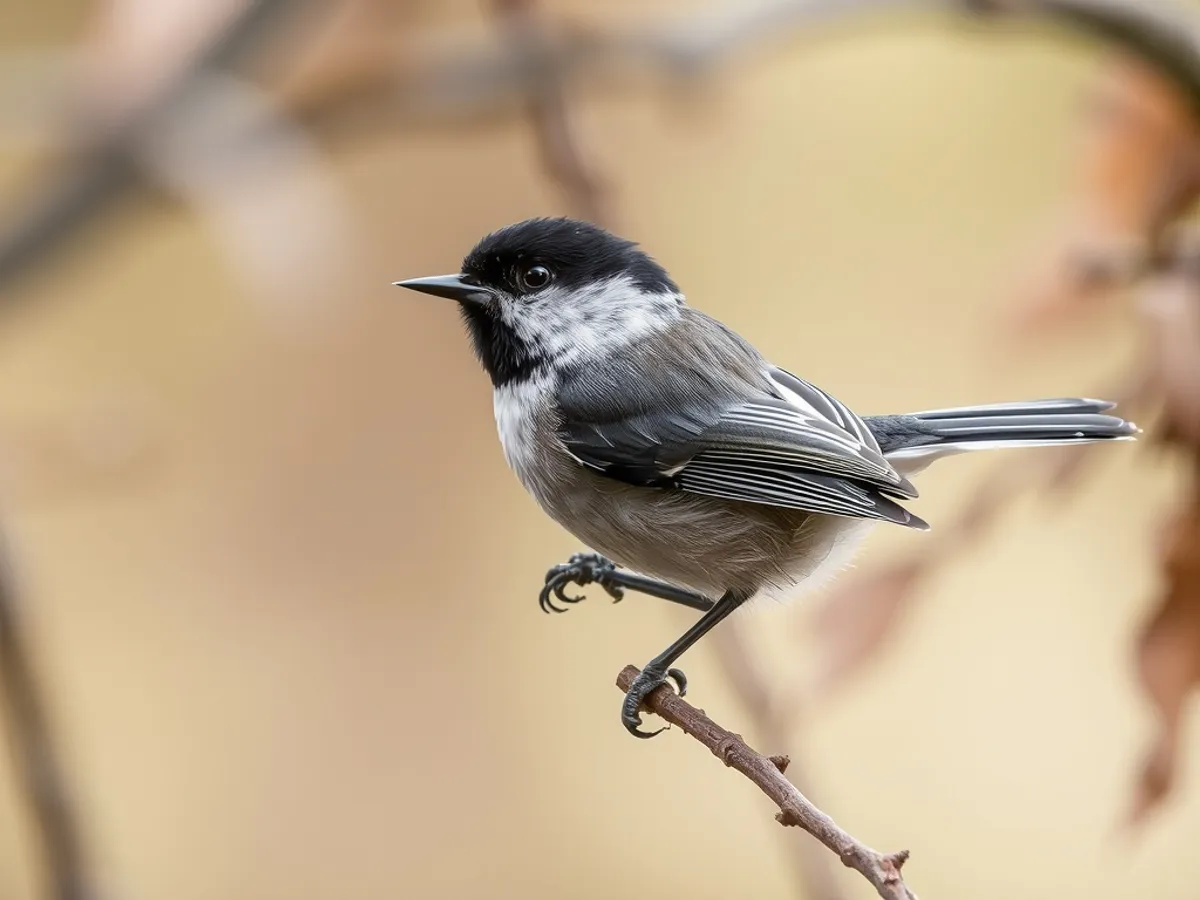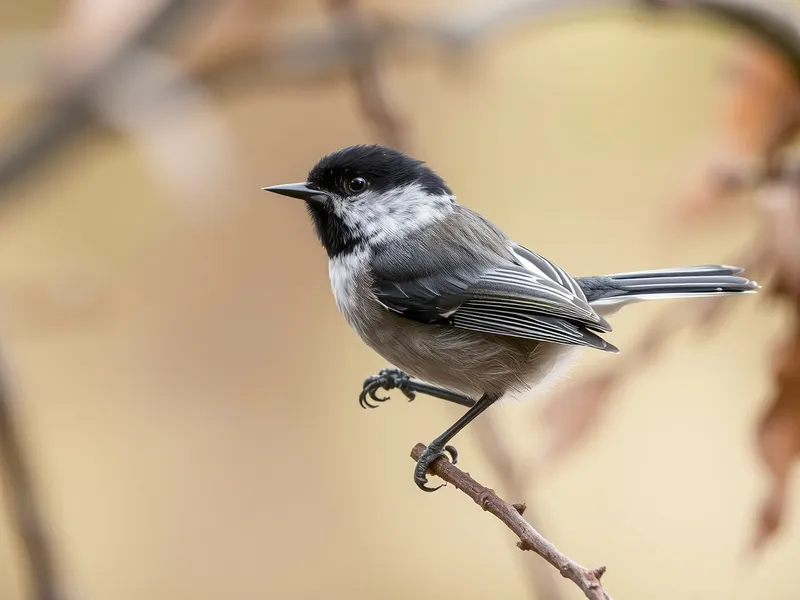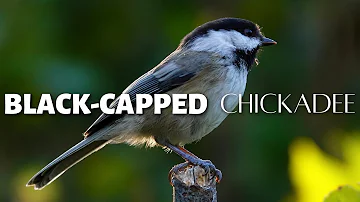
Black-capped Chickadee
Poecile atricapillus

Meet the Black-capped Chickadee
The Black-capped Chickadee is a small, lively songbird recognized by its distinctive black cap and bib, white cheeks, and soft gray back. Native to North America, it is highly adaptable, commonly found in forests, woodlands, parks, and suburban gardens. This inquisitive bird is known for its acrobatic feeding habits, hanging upside-down to access food and caching seeds to retrieve during winter. Its cheerful 'chick-a-dee-dee-dee' call is a familiar sound throughout its range, serving both as communication and a warning signal. The species exhibits remarkable memory abilities, allowing it to relocate hundreds of hidden food items each season.
Classification
Bird
Habitat
Deciduous and mixed forests, woodlands, parks, and residential areas
Diet
Omnivore
Lifespan
2-3 years in the wild
Conservation
Least Concern
Weight
9-14 grams
📖Fascinating Facts
Impressive Memory
Black-capped Chickadees can remember the locations of hundreds of food caches, even after weeks have passed.
Winter Survivors
These birds can enter a regulated hypothermia at night, lowering their body temperature by up to 12°C to save energy during cold weather.
Varied Calls
Chickadees use a complex system of calls, and the number of 'dees' in their 'chick-a-dee-dee' call indicates the level of danger nearby.
📋Detailed Description
The Black-capped Chickadee (Poecile atricapillus) is a small passerine bird, typically measuring 12–15 cm (4.7–5.9 in) in length and weighing 9–14 g (0.32–0.49 oz). It is instantly recognizable by its bold black cap and bib, contrasting sharply with white cheeks and a soft gray back, wings, and tail. The underparts are primarily white with buffy flanks. Its short, stout bill is well-adapted for gleaning insects and seeds. The species exhibits a rounded body, relatively large head, and a distinctive, short neck, giving it a 'big-headed' appearance. Black-capped Chickadees are agile and acrobatic, often seen hanging upside down while foraging. They possess a complex vocal repertoire, including the iconic 'chick-a-dee-dee-dee' alarm call and a clear, whistled 'fee-bee' song. Their brains undergo seasonal neurogenesis, allowing them to remember and update the locations of hundreds of cached food items. Socially, they form small, cohesive flocks in winter, with a linear dominance hierarchy that influences access to food and mates. During the breeding season, pairs become territorial and defend nesting sites vigorously. The species is highly adaptable, thriving in a variety of habitats from dense forests to urban parks and gardens.
💡 Did you know?
Despite their tiny size, Black-capped Chickadees are able to survive harsh northern winters by growing extra brain cells to remember food cache locations.
🔬Research & Sources
Wikipedia Summary
The black-capped chickadee is a small, nonmigratory, North American passerine bird that lives in deciduous and mixed forests. It is a member of the Paridae family, also known as tits. It has a distinct black cap on its head, a black bib underneath, and white cheeks. It has a white belly, buff sides, and grey wings, back, and tail. The bird is well known for its vocalizations, including its fee-bee call and its chick-a-dee-dee-dee call, from which it derives its name.
Last Modified: 6/4/2025
🎭Behavior & Social Structure
Black-capped Chickadees are diurnal, spending most daylight hours foraging for food. Their diet shifts seasonally: in summer, they consume a high proportion of insects and spiders, while in winter, seeds and berries become more important. They are known for their food caching behavior, hiding seeds and insects in bark crevices and other locations to retrieve later, a strategy supported by their exceptional spatial memory. Chickadees are highly social outside the breeding season, forming mixed-species flocks with nuthatches, woodpeckers, and kinglets, which enhances foraging efficiency and predator detection. Within flocks, a strict dominance hierarchy is maintained, with dominant individuals gaining priority access to food. Vocal communication is sophisticated; the number of 'dee' notes in their call increases with the perceived threat level of predators. They exhibit vigilant behaviors and use mobbing tactics to deter predators such as hawks and owls. Roosting occurs in tree cavities or dense vegetation, and individuals may use their own excavated holes or abandoned woodpecker nests.
👶Reproduction & Life Cycle
Breeding occurs from April to June, with pairs forming monogamous bonds that may persist for multiple seasons. Courtship involves vocal displays and aerial chases. Nests are typically excavated by the female in soft, decaying wood or natural cavities, lined with moss, animal fur, and plant down. Clutch size ranges from 6 to 8 eggs, which are white with fine reddish-brown spots. The female incubates the eggs for 12–13 days, during which the male provides food. After hatching, both parents feed the altricial chicks, which fledge at about 16 days old. Parental care continues for several weeks post-fledging, with juveniles learning foraging and survival skills. Chickadees may produce one brood per year, though second broods are occasionally reported in southern parts of their range.
🛡️Adaptations & Survival
The Black-capped Chickadee exhibits several remarkable adaptations for survival in temperate and boreal environments. Its ability to lower body temperature by up to 12°C (21°F) at night—a process called regulated hypothermia—conserves energy during cold winters. Dense plumage and behavioral adaptations, such as communal roosting and fluffing feathers, provide additional insulation. Their spatial memory is enhanced by seasonal neurogenesis in the hippocampus, allowing efficient retrieval of cached food. The species' vocal flexibility enables nuanced communication about predator type and threat level. Their small size and agility facilitate foraging in complex vegetation, and their strong, pointed bills are effective for extracting insects from bark and manipulating seeds.
🎨Cultural Significance
The Black-capped Chickadee holds a special place in North American culture, symbolizing cheerfulness, resilience, and curiosity. It is the official state bird of Massachusetts and Maine. Its distinctive calls are frequently referenced in literature and folklore, often representing the arrival of spring or the persistence of life through winter. Chickadees are popular among birdwatchers and are a common subject in nature art and photography. In some Indigenous traditions, chickadees are seen as messengers or symbols of truth and clarity. Their approachable nature and willingness to feed from human hands have made them beloved backyard visitors.
🔬Recent Research & Discoveries
Recent research has focused on the neurobiology of spatial memory in Black-capped Chickadees, revealing seasonal growth and pruning of hippocampal neurons in response to food caching demands. Studies on their vocalizations have demonstrated that chickadee calls encode detailed information about predator size and threat level, making them a model for animal communication research. Ongoing work examines the effects of climate change on hybrid zones with Carolina Chickadees, with genomic studies revealing introgression and adaptation patterns. Long-term banding studies have provided insights into lifespan (typically 2–3 years in the wild, with records up to 12 years), site fidelity, and dispersal. Research into their metabolic adaptations to cold environments continues to inform our understanding of avian thermoregulation.
🎥Wildlife Videos

The Black-capped Chickadee: One of the Beloved Birds of North America
One of the most beloved little birds, the Black-capped Chickadee is pretty common in most of North America. As some of you know ...
Lesley the Bird Nerd

Discover the Black-Capped Chickadee: Nature's Adorable Fluffball!
Unlock the secrets of the Black-Capped Chickadee in this enlightening journey through nature. Widely adored for their petite size ...
Moments of Poetry

Black-capped Chickadee | Nest Facts
In this video learn more about Black-capped Chickadees and their nests. Nest location, nest boxes, types of material used, egg ...
Lesley the Bird Nerd

Life Of A Black-capped Chickadee Family | Bird Nerd Diaries
If you enjoyed this video please help support the channel by SHARING it on Facebook and Twitter. It's a free way to help me ...
Lesley the Bird Nerd

The Fascinating Survival Strategies Of Black Capped Chickadees
The Black Capped Chickadee is one of my favorite animals, they've always been a point of curiosity but when I moved to the UP I ...
BK Curiosity

Black-capped Chickadee Most Asked Questions
Have you ever wondered? Where do Black-capped chickadees sleep in the winter? Or whether they mate for life or not?
Lesley the Bird Nerd
🌍Habitat Information
The Black-capped Chickadee typically inhabits Deciduous and mixed forests, woodlands, parks, and residential areas environments. Black-capped Chickadees have adapted to their environments with specialized features and behaviors.
Primary Habitat:
Deciduous and mixed forests, woodlands, parks, and residential areas
More detailed habitat information will be available soon.
🛡️Conservation Status
The Black-capped Chickadee is currently classified as Least Concern. Conservation efforts are crucial for preserving this species for future generations.
Common Threats:
- 🏠Habitat loss and fragmentation
- 🌡️Climate change impacts
- 🎯Hunting and poaching
- 🏭Human-wildlife conflict
⚠️Threats & Conservation Challenges
Currently classified as Least Concern by the IUCN, Black-capped Chickadee populations are stable across most of their range. However, local declines can occur due to habitat loss from deforestation, urbanization, and removal of deadwood (critical for nesting). Climate change poses a long-term threat by altering forest composition and shifting the southern range limit northward, potentially leading to hybridization with the closely related Carolina Chickadee (Poecile carolinensis) in overlapping zones. Window collisions, predation by domestic cats, and pesticide use also contribute to mortality. Despite these challenges, their adaptability to human-altered landscapes and use of bird feeders have helped sustain populations in suburban and urban areas.
🔬Scientific Classification
Scientific Name
Poecile atricapillus
Classification Hierarchy
🔍 About Taxonomic Classification
Taxonomic classification is a hierarchical system used by scientists to classify and organize living organisms based on shared characteristics and evolutionary relationships.
The system moves from broad categories (Kingdom) to increasingly specific ones, with each animal's scientific name typically consisting of its Genus and species.
📝Community Notes
Share your observations and insights about the Black-capped Chickadee with our community of wildlife enthusiasts.
Join Our Community
Sign in to share your observations and connect with fellow wildlife enthusiasts.
Sign In to ContributeNo community notes yet
Be the first to share your observations about the Black-capped Chickadee!
Explore Black-capped Chickadee
Select a tab above to learn more about this amazing animal.
📸Photo Gallery
No photos available for this animal yet.
🌟Discover More Wildlife
Continue your journey of discovery with more fascinating animals from our database
